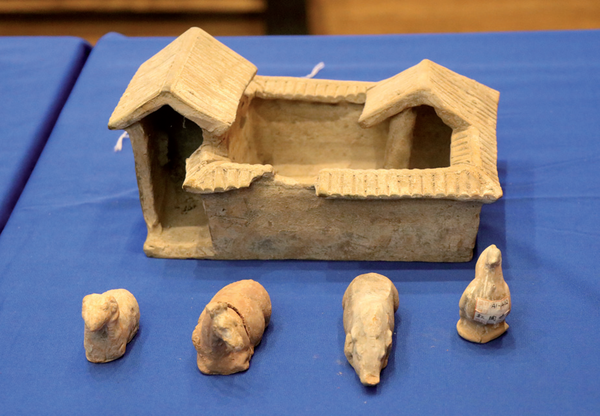US Will Return 361 Rare Artifacts to China

A green glaze pottery couch dates to the Ming Dynasty. ZHANG RUINAN / CHINA DAILY
A green couch of glazed pottery from the Ming Dynasty (1368-1644) and pottery animals with a livestock shed from the Han Dynasty (206 BC-AD 220) are being carefully packed for the trip home to China.
They were among 361 Chinese relics and artifacts bound for their land of origin shown to the media on Thursday by the US government at the Eiteljorg Museum of American Indians and Western Art in Indianapolis, Indiana.
The items, including stoneware, jade objects, bronze weapons and pottery ranging from the Neolithic Age (10,000-2,000 BC) to the Qing Dynasty (1644-1911), form the largest repatriation of relics from the United States since 2009, when the US and China signed an agreement to enhance such cooperation.
"The US and China have a long and rewarding history of partnerships across many fronts," said Kristi Johnson, chief of the FBI's Transnational Organized Crime section. "Today marks another milestone of this important partnership. ... Through a long and effective collaborative effort between the FBI and our partners in China's National Cultural Heritage Administration, we were able to identify a total of 361 objects that rightfully belong to China," Johnson said.
Chinese cultural objects lost abroad constitute a significant part of the cultural heritage of China, said Hu Bing, deputy director of the heritage administration.
"This repatriation presents the outcome of a continuing effort during five years by China and the US," Hu said. "It not only demonstrates concerted efforts of China and the US to support and meet each other halfway in the recovery and return of cultural property ... but also contributes to mutual understanding and trust between the two peoples."
Hu said it set an example for ensuring the safety of cultural heritage globally and was an invaluable gift toward the celebration of the 40th anniversary of the establishment of China-US relations.
Hu said it also could be a starting point, together with the US, in establishing and improving mechanisms for information sharing about stolen cultural objects, and increasing international exchanges and teamwork against the looting and theft of cultural property.
In a regular news briefing on Friday, Foreign Ministry spokesman Lu Kang expressed the Chinese government's appreciation for repatriation of the relics by the US. Cooperation in cultural heritage protection is an important part of people-to-people exchanges and China is willing to make joint efforts with the US to further promote cooperation in the field, he said.

A set of pottery animals in front of a livestock den from the Han Dynasty. ZHANG RUINAN / CHINA DAILY
Aleisha Woodward, deputy assistant secretary for policy at the US State Department Bureau of Educational and Cultural Affairs, called it "a wonderful opportunity for us to celebrate the cultural heritage that we both respect".
In 2009, the two nations signed their first agreement on the preservation of cultural heritage. The US has returned two groups of 36 relics and artifacts to China in March 2011 and December 2015.
The 361 objects were among about 7,000 cultural artifacts the FBI seized in Indiana when it raided the home of a 91-year-old ex-missionary named Donald Miller in 2014.
